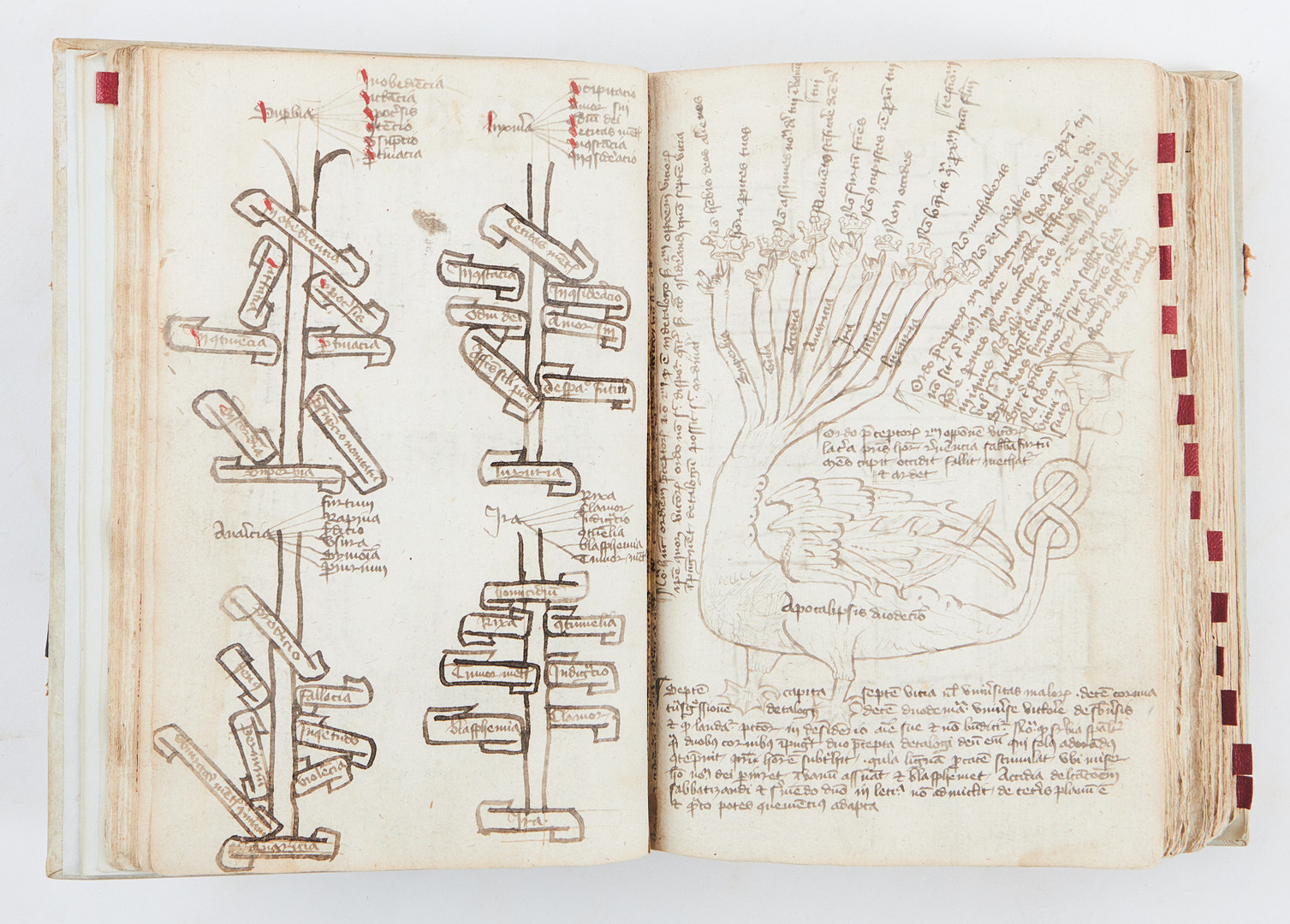
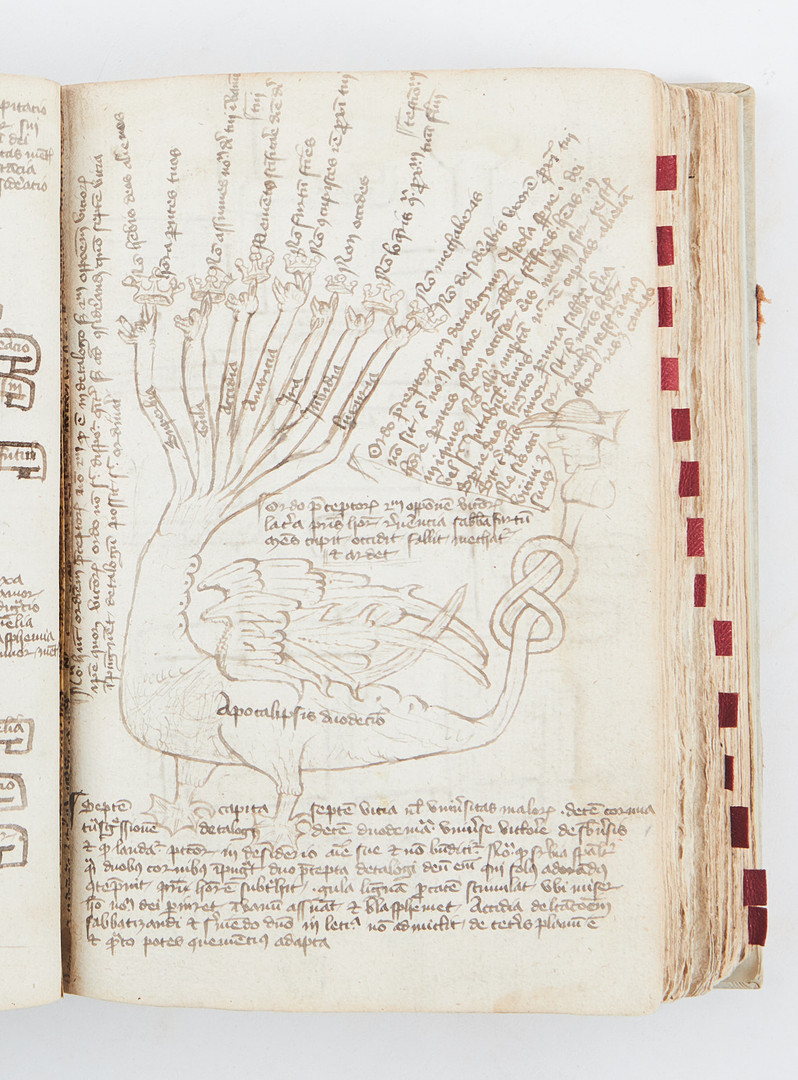
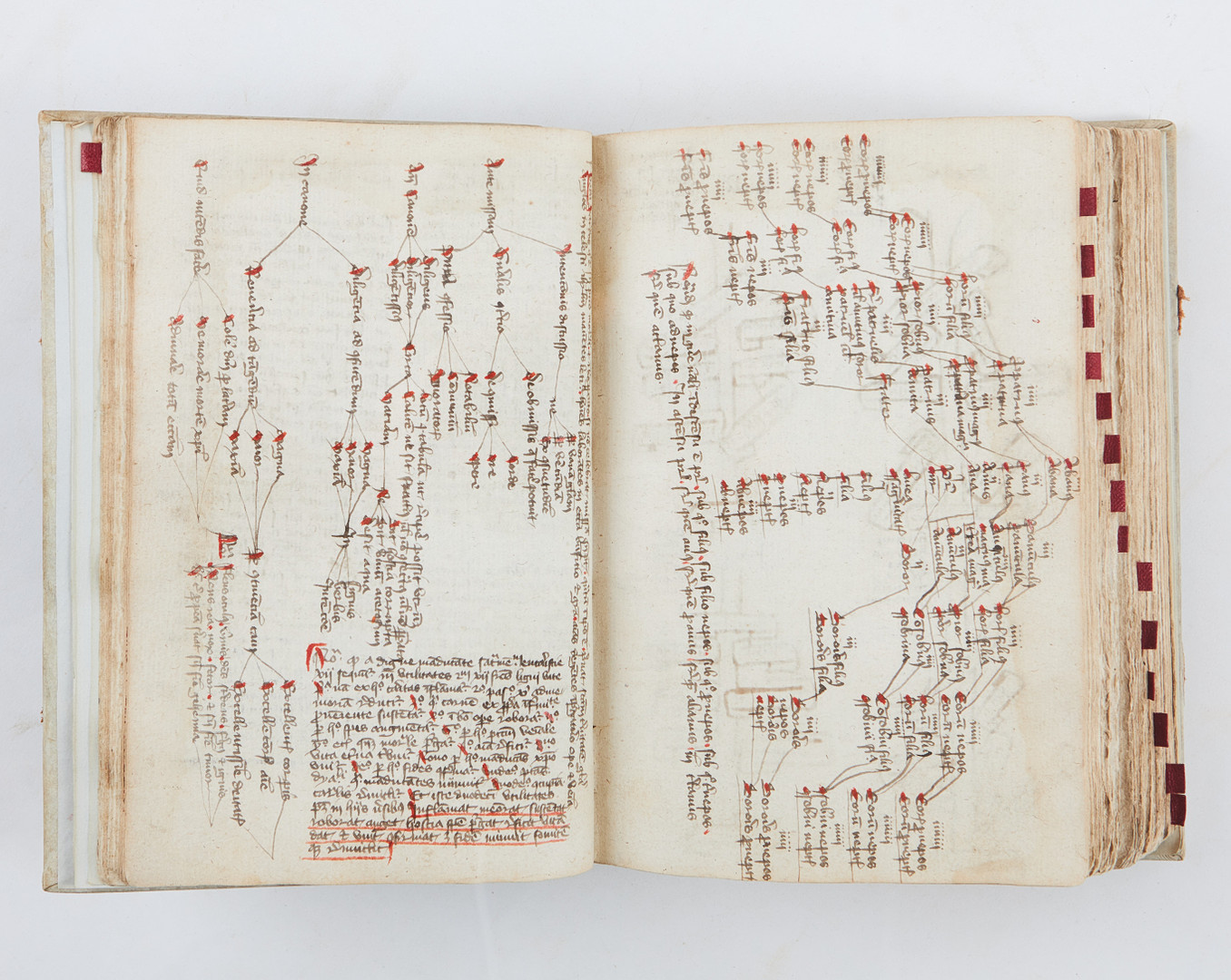
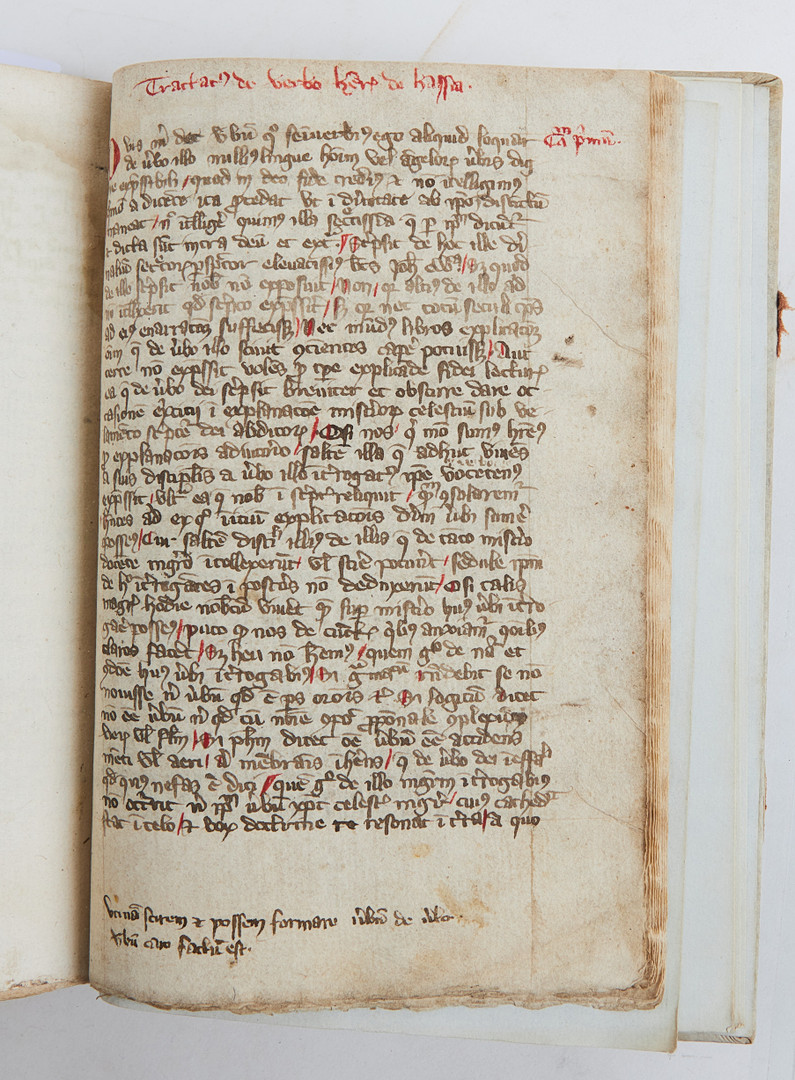
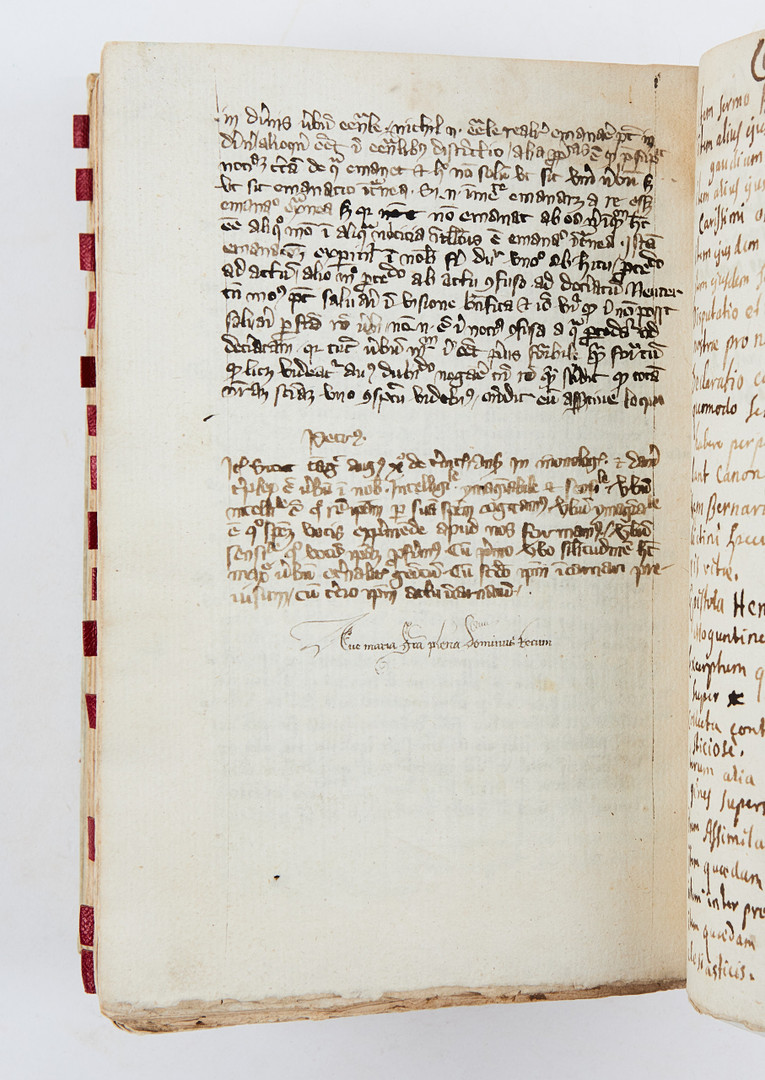
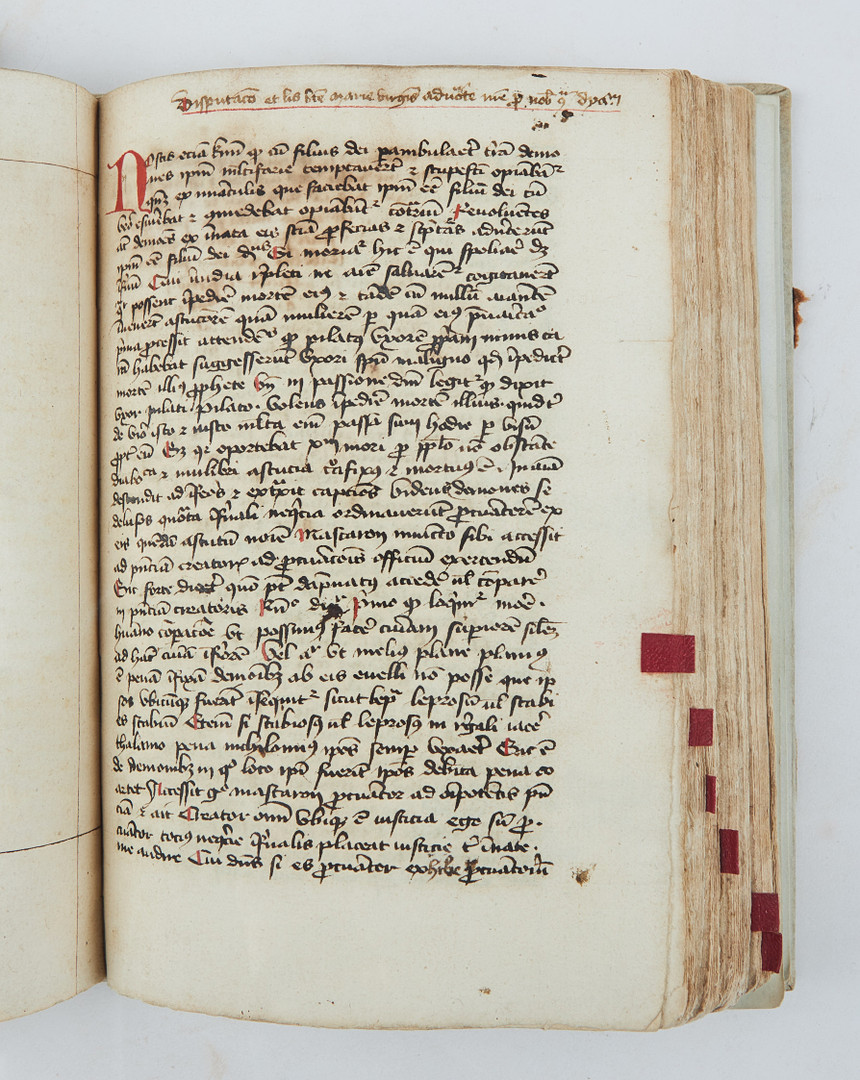
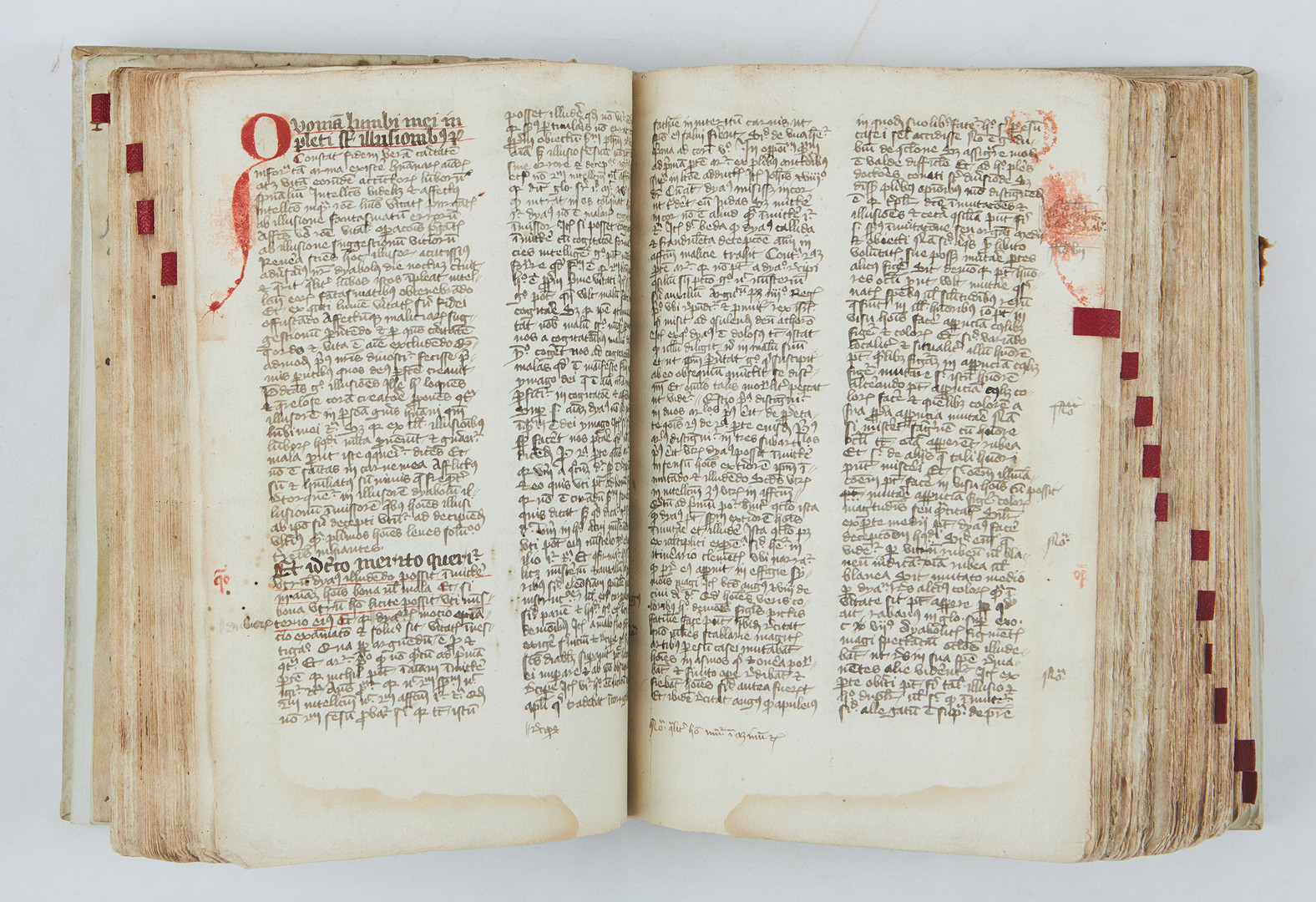
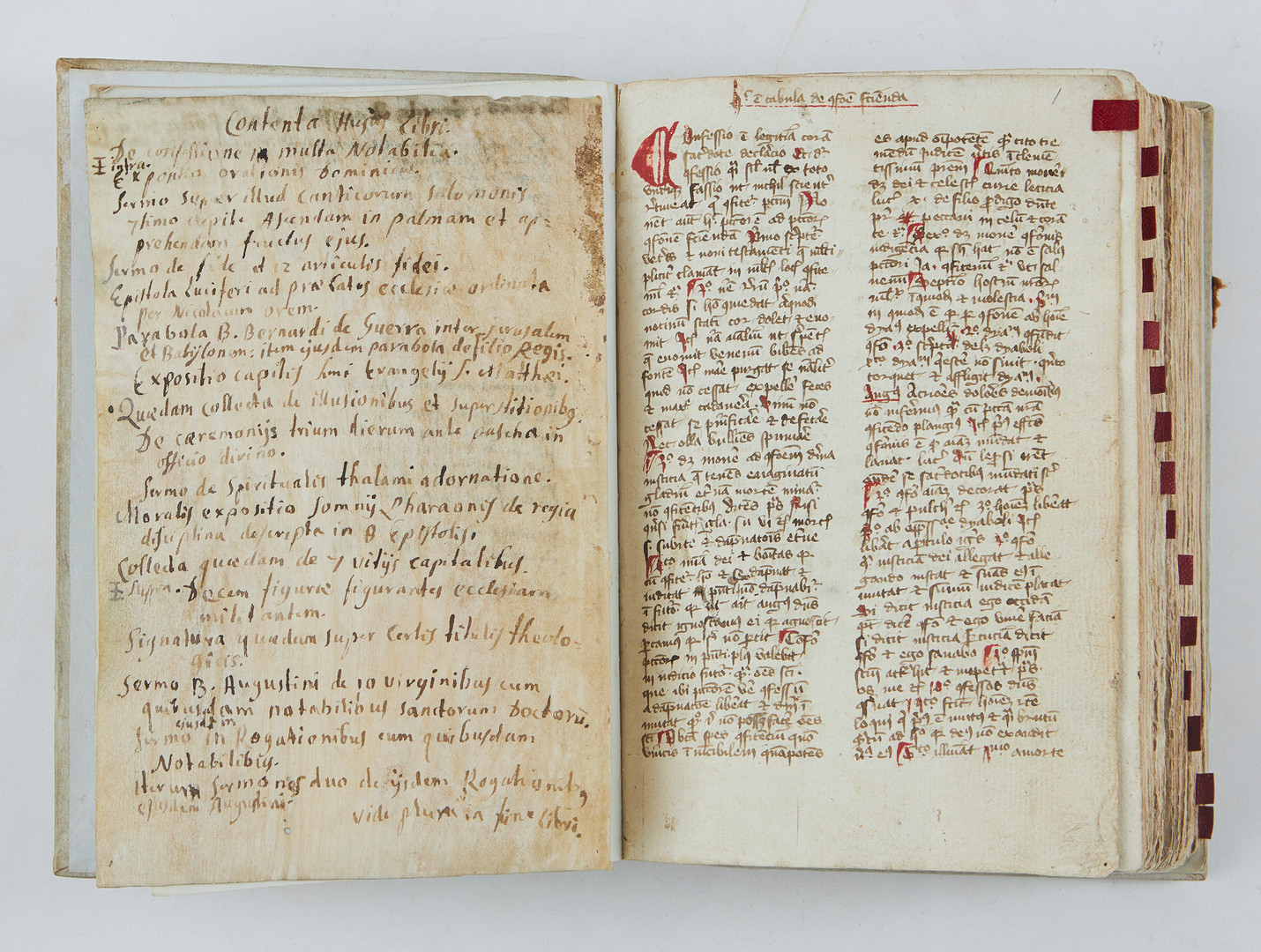
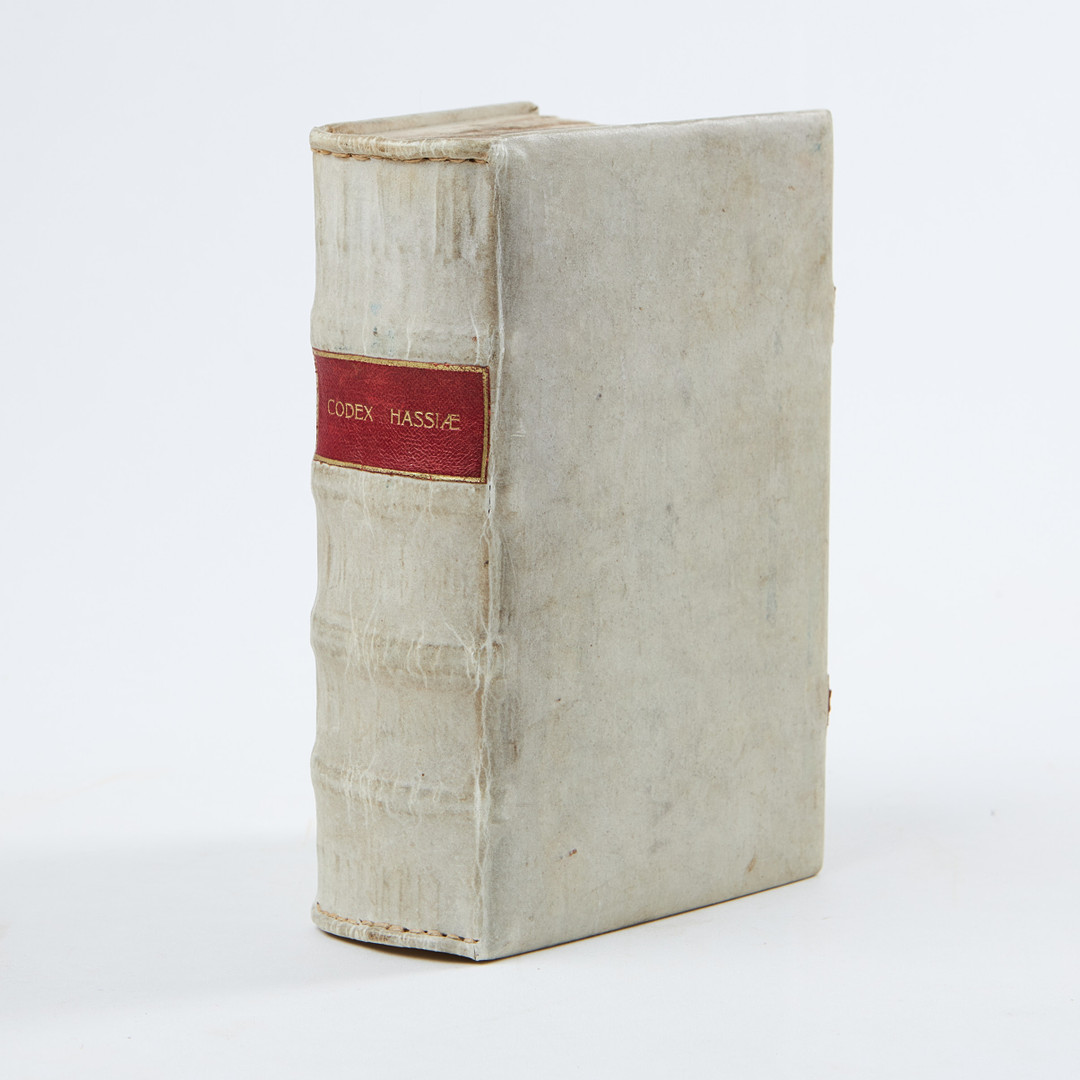
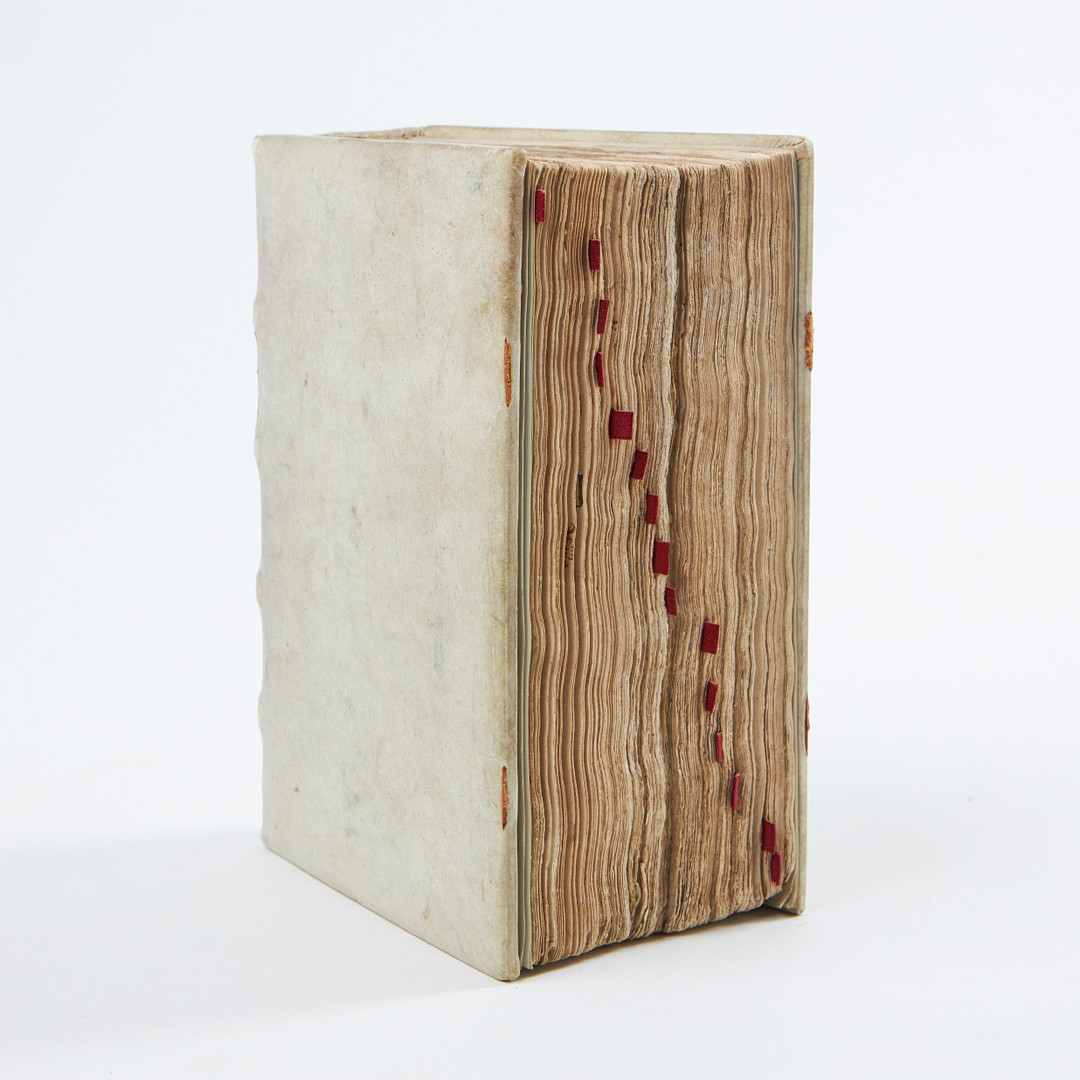
DEVOTIONAL AND CONFESSIONAL SAMMELBAND, MANUSCRIPT 15TH C.
| Sold for | 110 000 SEK |
|---|---|
| Klubbas | Closed |
| Hus | Stockholms Auktionsverk Nybrogatan 32 |
| Föremålet har klubbats. | |
Devotional and confessional sammelband, including Heinrich von Langenstein, Tractatus de verbo in divinis and the same author’s letter to the deacon of Mainz, the satirical Epistola Luciferi and numerous other texts, with a full-page illustration of the Scarlet Beast of the Apocalypse, in Latin with a few lines in Middle Low German, illustrated manuscript on paper Germany, second half of the fifteenth century.
215 x 150mm., a sammelband of 273 leaves (plus an original endleaf once from front of codex, now loose in volume), wanting a single leaf, else complete, collation: i16, ii-vii12, viii8, ix9 (wants a leaf after 7 th leaf), x10, xi-xii12, xiii8, xiv-xviii12, xix16, xx2 (a bifolium added to complete the text of the previous quire), xxi6 (i-v blank), xxii12, xxiii6, xxiv-xxv12, text in a variety of formats (opening text in double column of 39 lines, in a series of small German late medieval bookhands much influenced by secretarial letter forms, titles underlined in dark red, capitals touched in red, paraphs and initials in red, three pages with full-page diagrams of numerous virtues and vices arranged on banderoles mounted on staffs, one full-page line-drawing of the Scarlet Beast of the Apocalypse (following Revelation 17:3 and with seven crowned heads, a winged body and a tail that forms a geometric figure-of-eight knot before terminating in a human head, all surrounded by explanatory text and inscriptions), paper with three watermarks (cow’s head, coat-of-arms and arrow; none distinct enough to allow close identification), at least two textual components here having a separate
existence as unbound booklet (this shown by fold marks or discolouration to initial leaves), strips from a medieval manuscript reused as gutter-strengtheners in fold points of the centre of most quires, modern red leather tabs at foredge, some small spots and stains, else good condition; bound in modern white vellum over early bevelled wooden boards, and sewn on early binding structures of 4 large double thongs, this restored with new vellum added over and a modern red leather title plate to spine (with “Codex Hassiae”; this title perhaps inspired by Sotheby’s 1910 cataloguing that appears to ascribe a great deal of the book to Heinrich von Langenstein/Henricus de Hassia) by Otto Schoultz of Göteborg (1856-1921), remnants of leather ties at foredge
Provenance:
1. From the Carthusian Monastery of St. Barbara in Cologne (this house was one of a handful
of provenances given by Phillipps for the source of the van Ess manuscripts, and while this
volume is not marked by Phillipps as from that house, the hands of the contents lists on the
endleaves here precisely agree with other volumes from that house, see for example the
University of Kansas, Kenneth Spencer Research Library, MS. C91, olim Phillipps MS. 646,
and Philadelphia, University of Pennsylvania, Kislak Center for Special Collections, MS.
Codex 1164, olim Phillipps MS. 645). The house was founded in 1334, and grew to be the
largest Charterhouse in Germany. Its library was restocked after a disastrous fire in 1451,
with the present volume among those added then. The house was dissolved in 1794, when
some of the manuscripts were sent to Paris, others to a new school founded in Cologne, and
the remainder sold to the local bookdealer Johann Matthias Heberle.
2. Leander van Ess (1772-1847), pastor of Swalenberg, theologian at Marburg University and
German translator of the New Testament, who bought the books that went from the Cologne Charterhouse to Heberle en bloc. On Ess’ library see: M. Mc C.Gatch, ‘The Book Collections
and the Library of Leander van Ess’, in 'So precious a foundation', the Library of Leander
Van Ess at the Burke Library of Union Theological Seminary in the City of New York (1996).
3. Sir Thomas Phillipps (1792-1872), the single greatest manuscript collector to have ever
lived, who assembled a collection of 60,000 such books; this his MS. 661 (named ‘Tractates
de confessione’ in his catalogue), and acquired as part of the whole of van Ess’ collection of
manuscripts and incunables. This volume then in Phillipps’ sale in Sotheby’s, London, 7 June
1910, lot 410, for £1, 10 sh., to Paul Gottschalk (1880-1969), the German-American
bookdealer.
4. From the collection of Adolf Lagerfelt (1897-1967), vice-consul to the Middle East; from
his library at Säbylund, no. ‘185’. Rebound and restored for him by Otto Schoultz (1856-
1921) of Göteborg.
Text:
This is a densely packed compendium of devotional and confessional material, in which
space left by the initial scribes has often been returned to and filled with further excerpts and
short texts. It opens with a confessional manual with associated materials all apparently
copied in a single hand (opening “Confessio est legitima coram sacerdote peccatorum
declaratio ...”; fols. 1r-27r, and including a few lines translated into Middle Low German [fol.
19r], a short text listing the electors of Germany [fol. 21r] and the pages with the ‘moral
diagrams’ of the virtues and vices and the drawing of the Scarlet Beast of the Apocalypse
[fol. 23r]). This is followed by a number of other confessional collections and works,
including Johannes Nider’s Manuale Confessorum (fols. 47v-76r, opening “Quoniam iuxta
beati Gregorii ...”, and here named “Stellam pulchra” in the explicit), and the Processus
humani generis (fols. 162r-70r, opening “Nostis frates karissimi quod cum filius Dei
perambularet terram ...”). Interspersed with these are excerpts from works by common
authors such as St. Augustine, Bernard of Clairvaux and Thomas Aquinas, as well as the
Rhenish author Caesarius of Heisterbach (c. 1180-c. 1240). The codex also includes a copy of
the popular Epistola Luciferi, purporting to be a satirical letter written by the devil attacking
the secular clergy, often attributed to Heinrich von Langenstein (fols. 34r-35v, opening
“Lucifer princeps tenebrarum ...”, and here attributed in the rubric to Nicholas Oresme, but
more probably the work of Pierre Ceffons [fl. 1348-53], abbot of Clairvaux: on this text see
C. Schabel, ‘Lucifer princeps tenebrarum … The Epistola Luciferi and Other Correspondence
of the Cistercian Pierre Ceffons (fl. 1348-1353)’, Vivarium, 56, 2018, pp. 126-75). In
addition, the codex contains works by Heinrich von Langenstein (c. 1325-97), the vice-
chancellor of the University of Paris, and following his expulsion from there for refusing to
swear allegiance to the Avignon Pope Clement VII, professor in the University of Vienna. His
Tractatus de verbo in divinis ends the volume (fols. 262r-269v, with attribution him in the
rubric), and his letter to the Eberhard von Yppelbrunn, deacon of Mainz occurs on fols. 175r-
80r (opening “Amicorum sincerissimo virtutis et scientie meritis reverendo domino E. de
ippelborn …”, and naming its author as “H. Langensteyn” in the opening lines of the text).
Our thanks to Dr. Timothy Bolton for assistance in cataloguing this item.
See text.
